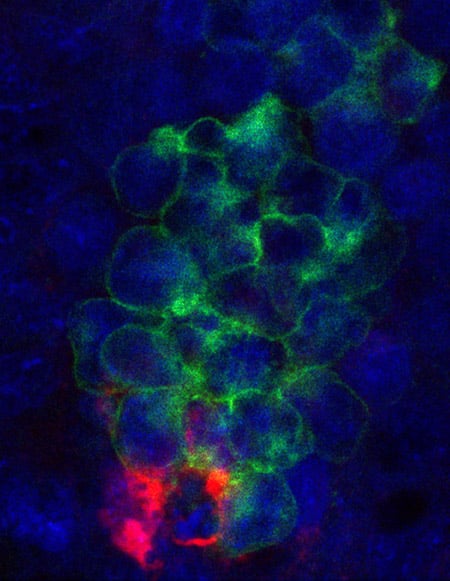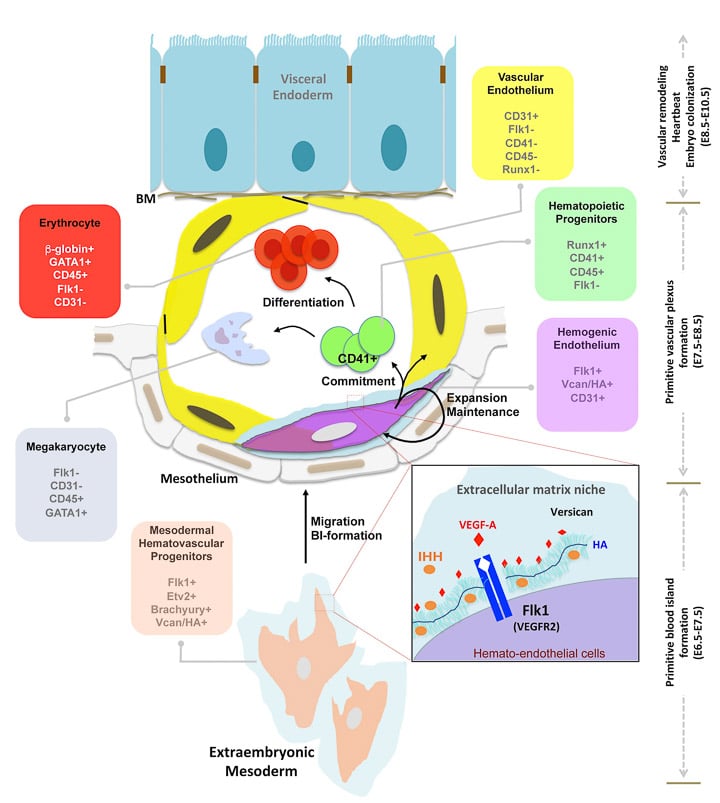Vasculogenesis and primary hematopoiesis
 Versican, the best characterized ADAMTS9 substrate is known to be a crucial component of the cardiac jelly and versican KO mouse mutants were thought to succumb by their heart defects. However, we have now discovered that versican expression begins much earlier in mouse embryos than previously reported and it first appears at gastrulation surrounding the Flk1+ haemato-vascular endothelial progenitor cells. These specialized cells gives rise to the blood island ring where we observe high levels of versican staining (image-1, Nandadasa et al, Matrix Biol. 2021). In a paradigm-shifting discovery, we show that versican together with hyaluronan provides a crucial ECM niche surrounding these unique progenitor cells which gives rise to the entire blood and vascular lineages of the embryo. We have discovered that versican as well as hyaluronan KO mice completely lack vasculature and show greatly reduced hematopoiesis. Supporting observations made by other groups, we also identified that the chondroitin sulfate GAG chains of versican are essential to sequestering key growth factors involved in vasculogenesis, VEGF and Ihh.
Versican, the best characterized ADAMTS9 substrate is known to be a crucial component of the cardiac jelly and versican KO mouse mutants were thought to succumb by their heart defects. However, we have now discovered that versican expression begins much earlier in mouse embryos than previously reported and it first appears at gastrulation surrounding the Flk1+ haemato-vascular endothelial progenitor cells. These specialized cells gives rise to the blood island ring where we observe high levels of versican staining (image-1, Nandadasa et al, Matrix Biol. 2021). In a paradigm-shifting discovery, we show that versican together with hyaluronan provides a crucial ECM niche surrounding these unique progenitor cells which gives rise to the entire blood and vascular lineages of the embryo. We have discovered that versican as well as hyaluronan KO mice completely lack vasculature and show greatly reduced hematopoiesis. Supporting observations made by other groups, we also identified that the chondroitin sulfate GAG chains of versican are essential to sequestering key growth factors involved in vasculogenesis, VEGF and Ihh.
Intriguingly, loss of versican leads to a complete loss of hyaluronan (HA) in versican KO mouse embryos and loss of HA in Has1+2+3 triple KO or Has2 single KO mouse embryos alone also leads to versican catabolism. Loss of HA in versican KO embryos and cell lines seems to be mediated through up regulation and activation of TMEM2, a major extracellular hyaluronidase. In future research we will continue to study the molecular mechanism of this crucial ECM niche in embryonic tissues as well as its presence and importance in adult diseases and angiogenesis.



